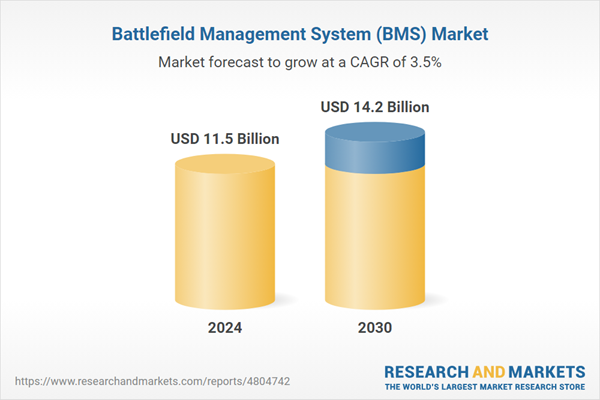The global market for Battlefield Management System (BMS) was valued at US$11.5 Billion in 2024 and is projected to reach US$14.2 Billion by 2030, growing at a CAGR of 3.5% from 2024 to 2030. This comprehensive report provides an in-depth analysis of market trends, drivers, and forecasts, helping you make informed business decisions. The report includes the most recent global tariff developments and how they impact the Battlefield Management System (BMS) market.
Segments: Platform (Armored Vehicles, Soldier Systems, Headquarter & Command Centers); System (Navigation, Imaging & Mapping System, Communication & Networking System, Computing System, Command & Control).
Geographic Regions/Countries: World; United States; Canada; Japan; China; Europe (France; Germany; Italy; United Kingdom; and Rest of Europe); Asia-Pacific; Rest of World.
The analysts continuously track trade developments worldwide, drawing insights from leading global economists and over 200 industry and policy institutions, including think tanks, trade organizations, and national economic advisory bodies. This intelligence is integrated into forecasting models to provide timely, data-driven analysis of emerging risks and opportunities.
Global Battlefield Management System (BMS) Market - Key Trends and Drivers Summarized
What Is a Battlefield Management System and Why Is It Critical in Modern Warfare?
A Battlefield Management System (BMS) is an integrated, real-time information system that plays a pivotal role in modern warfare by providing commanders and troops with a comprehensive view of the battlefield. This system collects, processes, and disseminates data from various sources, including sensors, reconnaissance units, and communication networks, to deliver actionable intelligence and a synchronized operational picture. The BMS enables military forces to make informed decisions, coordinate movements, and execute missions with precision and speed. By enhancing situational awareness and improving command and control capabilities, the BMS is essential in ensuring mission success in complex and dynamic combat environments. As warfare becomes increasingly network-centric, the importance of a robust and reliable BMS in managing and executing military operations continues to grow, making it a critical asset for armed forces around the world.How Are Technological Innovations Shaping Battlefield Management Systems?
Technological advancements are significantly shaping the evolution of Battlefield Management Systems, making them more powerful, adaptable, and resilient in the face of modern military challenges. Innovations in artificial intelligence (AI) and machine learning are enabling BMS to process vast amounts of data in real-time, offering predictive analytics and decision support that enhance the speed and accuracy of military operations. The integration of advanced communication technologies, such as secure satellite links and high-frequency radios, ensures that information is transmitted quickly and reliably across the battlefield, even in hostile environments. Additionally, the development of modular and scalable BMS architectures allows for greater flexibility in deployment, enabling forces to tailor the system to specific mission requirements. The incorporation of cybersecurity measures is also becoming increasingly important, as BMS must be protected against cyber threats that could compromise the integrity and effectiveness of military operations. These technological innovations are driving the continuous improvement of BMS, making them indispensable in modern warfare.Why Is the Demand for Battlefield Management Systems Increasing?
The demand for Battlefield Management Systems is increasing due to the growing complexity of modern warfare, which requires highly coordinated and information-driven military operations. As conflicts become more asymmetric and involve a range of different threats, from conventional forces to cyber-attacks, the need for real-time situational awareness and seamless communication among units is paramount. BMS provides the tools necessary to manage these complexities, ensuring that commanders have the information they need to respond to rapidly changing conditions on the ground. The rise of network-centric warfare, where the ability to share and act on information quickly is a decisive factor, is also driving the adoption of BMS. Furthermore, the increasing reliance on joint and coalition operations, where multiple forces must work together seamlessly, has heightened the importance of interoperable BMS platforms. As military forces around the world continue to modernize and adapt to new threats, the demand for advanced Battlefield Management Systems is set to grow.What’s Driving the Growth of the Battlefield Management System Market?
The growth in the Battlefield Management System market is driven by several key factors, including the escalating complexity of modern military operations, which necessitates advanced tools for real-time information sharing and decision-making. Technological advancements, particularly in AI, communication, and cybersecurity, are also propelling market expansion by enhancing the capabilities and resilience of BMS platforms. The shift towards network-centric warfare and the increasing need for interoperability in joint and coalition operations are further driving the adoption of BMS. Additionally, the growing emphasis on modernizing military forces to counter new and evolving threats is encouraging investments in advanced battlefield management technologies. As these factors converge, the Battlefield Management System market is poised for significant growth, supported by continuous innovation and the increasing importance of information superiority in modern combat scenarios.Report Scope
The report analyzes the Battlefield Management System (BMS) market, presented in terms of units. The analysis covers the key segments and geographic regions outlined below.Segments: Platform (Armored Vehicles, Soldier Systems, Headquarter & Command Centers); System (Navigation, Imaging & Mapping System, Communication & Networking System, Computing System, Command & Control).
Geographic Regions/Countries: World; United States; Canada; Japan; China; Europe (France; Germany; Italy; United Kingdom; and Rest of Europe); Asia-Pacific; Rest of World.
Key Insights:
- Market Growth: Understand the significant growth trajectory of the Armored Vehicles Platform segment, which is expected to reach US$5.8 Billion by 2030 with a CAGR of a 3.3%. The Soldier Systems Platform segment is also set to grow at 2.9% CAGR over the analysis period.
- Regional Analysis: Gain insights into the U.S. market, valued at $3.1 Billion in 2024, and China, forecasted to grow at an impressive 3.4% CAGR to reach $2.3 Billion by 2030. Discover growth trends in other key regions, including Japan, Canada, Germany, and the Asia-Pacific.
Why You Should Buy This Report:
- Detailed Market Analysis: Access a thorough analysis of the Global Battlefield Management System (BMS) Market, covering all major geographic regions and market segments.
- Competitive Insights: Get an overview of the competitive landscape, including the market presence of major players across different geographies.
- Future Trends and Drivers: Understand the key trends and drivers shaping the future of the Global Battlefield Management System (BMS) Market.
- Actionable Insights: Benefit from actionable insights that can help you identify new revenue opportunities and make strategic business decisions.
Key Questions Answered:
- How is the Global Battlefield Management System (BMS) Market expected to evolve by 2030?
- What are the main drivers and restraints affecting the market?
- Which market segments will grow the most over the forecast period?
- How will market shares for different regions and segments change by 2030?
- Who are the leading players in the market, and what are their prospects?
Report Features:
- Comprehensive Market Data: Independent analysis of annual sales and market forecasts in US$ Million from 2024 to 2030.
- In-Depth Regional Analysis: Detailed insights into key markets, including the U.S., China, Japan, Canada, Europe, Asia-Pacific, Latin America, Middle East, and Africa.
- Company Profiles: Coverage of players such as BAE Systems Plc, Collins Aerospace, General Dynamics Corporation, KNDS, Kratos Networks and more.
- Complimentary Updates: Receive free report updates for one year to keep you informed of the latest market developments.
Some of the 47 companies featured in this Battlefield Management System (BMS) market report include:
- BAE Systems Plc
- Collins Aerospace
- General Dynamics Corporation
- KNDS
- Kratos Networks
- L3Harris Technologies, Inc.
- Leonardo SpA
- Northrop Grumman Corporation
- SAAB AB
- Thales Group
Tariff Impact Analysis: Key Insights for 2025
Global tariff negotiations across 180+ countries are reshaping supply chains, costs, and competitiveness. This report reflects the latest developments as of April 2025 and incorporates forward-looking insights into the market outlook.The analysts continuously track trade developments worldwide, drawing insights from leading global economists and over 200 industry and policy institutions, including think tanks, trade organizations, and national economic advisory bodies. This intelligence is integrated into forecasting models to provide timely, data-driven analysis of emerging risks and opportunities.
What’s Included in This Edition:
- Tariff-adjusted market forecasts by region and segment
- Analysis of cost and supply chain implications by sourcing and trade exposure
- Strategic insights into geographic shifts
Buyers receive a free July 2025 update with:
- Finalized tariff impacts and new trade agreement effects
- Updated projections reflecting global sourcing and cost shifts
- Expanded country-specific coverage across the industry
Table of Contents
I. METHODOLOGYII. EXECUTIVE SUMMARY2. FOCUS ON SELECT PLAYERSIII. MARKET ANALYSISIV. COMPETITION
1. MARKET OVERVIEW
3. MARKET TRENDS & DRIVERS
4. GLOBAL MARKET PERSPECTIVE
UNITED STATES
CANADA
JAPAN
CHINA
EUROPE
FRANCE
GERMANY
ITALY
UNITED KINGDOM
REST OF EUROPE
ASIA-PACIFIC
REST OF WORLD
Companies Mentioned (Partial List)
A selection of companies mentioned in this report includes, but is not limited to:
- BAE Systems Plc
- Collins Aerospace
- General Dynamics Corporation
- KNDS
- Kratos Networks
- L3Harris Technologies, Inc.
- Leonardo SpA
- Northrop Grumman Corporation
- SAAB AB
- Thales Group
Table Information
| Report Attribute | Details |
|---|---|
| No. of Pages | 247 |
| Published | April 2025 |
| Forecast Period | 2024 - 2030 |
| Estimated Market Value ( USD | $ 11.5 Billion |
| Forecasted Market Value ( USD | $ 14.2 Billion |
| Compound Annual Growth Rate | 3.5% |
| Regions Covered | Global |









